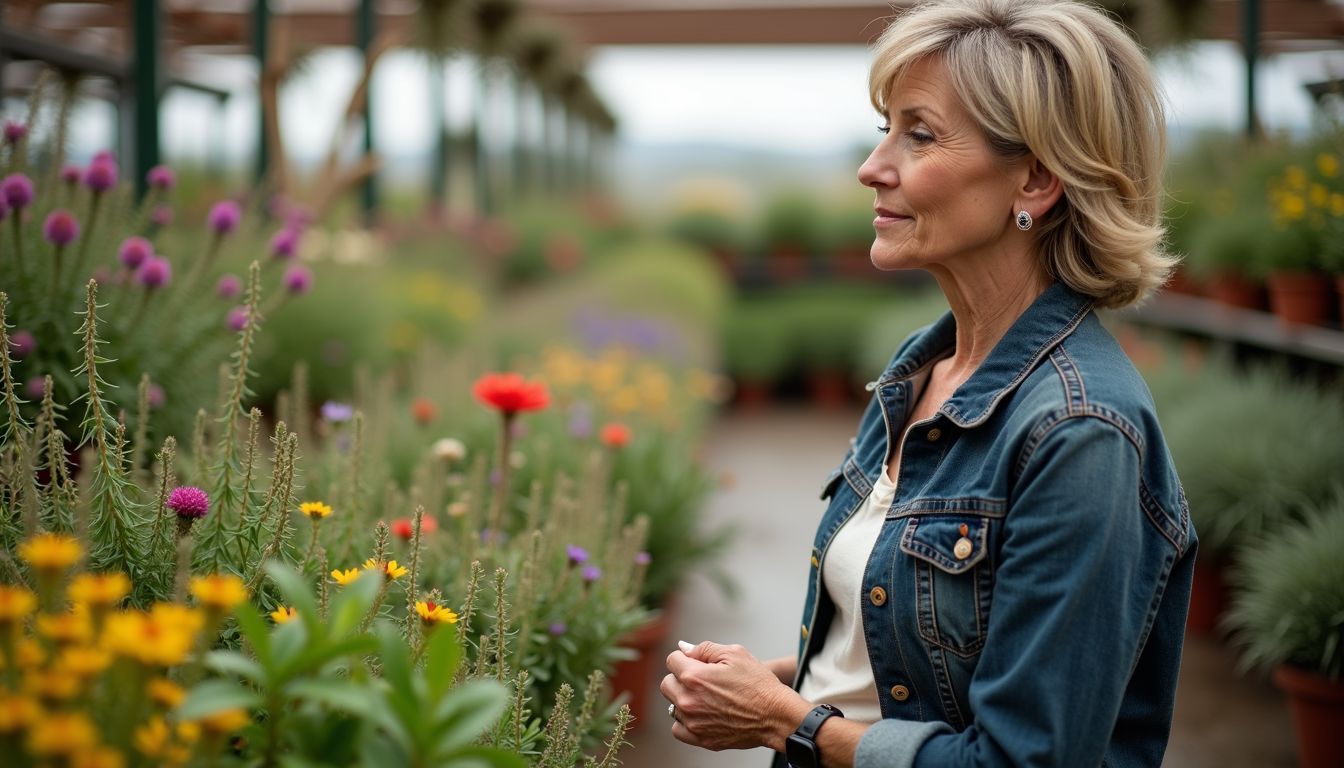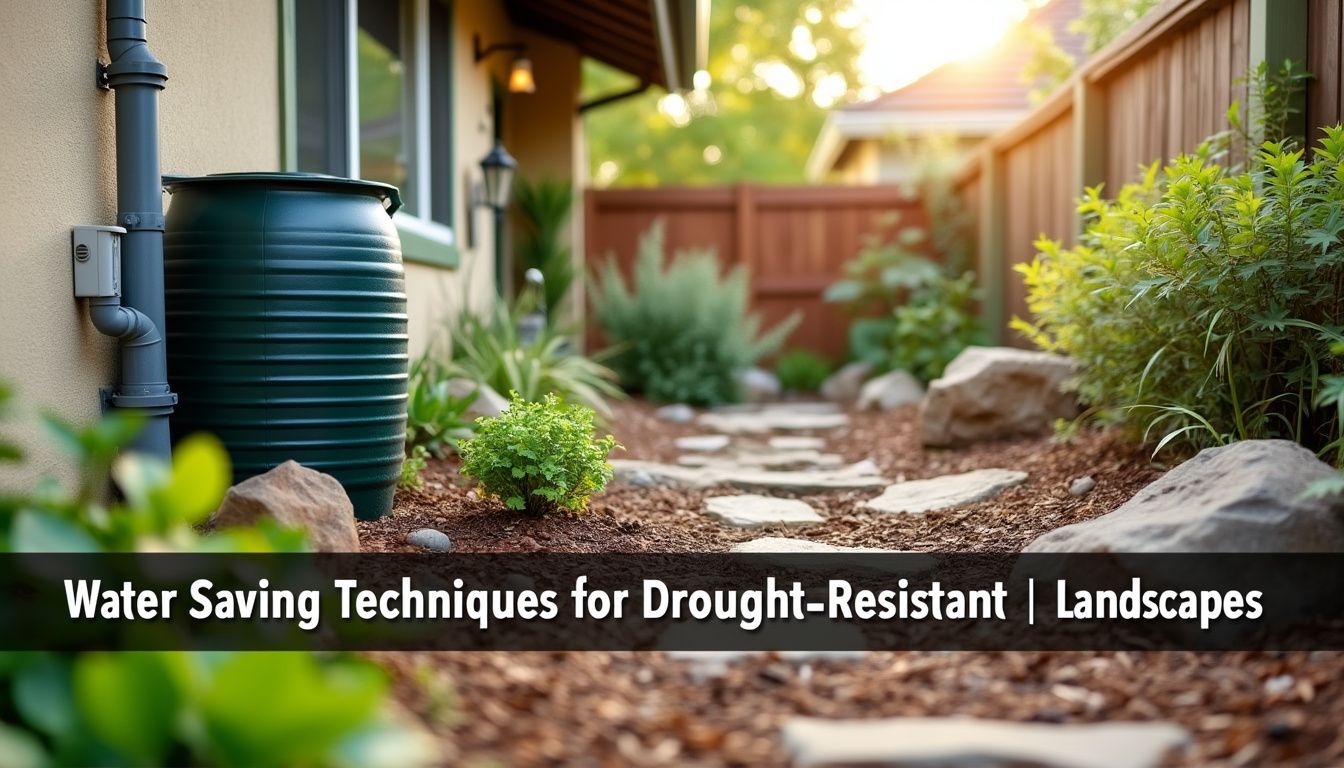Are your plants thirsty again but you’re worried about water waste? One fact is clear: drought-tolerant landscapes can cut water use dramatically. This article will show you simple ways to save water and keep your garden lively.
Let’s make every drop count!
Plant Selection for Drought-Tolerant Landscapes

Picking the right plants makes all the difference in crafting a drought-tolerant landscape. Go for species that thrive on less water, such as native plants well-suited to your local climate.
These hardy choices adapt better and demand fewer resources. Look out for varieties with deep roots, fleshy leaves, or low water needs; they’re champions at surviving dry spells. Understanding your garden’s specific conditions—like soil type and sun exposure—also guides you to make smart selections that enhance your yard’s aesthetics without guzzling precious H2O.
Integrating waterwise landscaping into your outdoor space doesn’t mean sacrificing beauty for utility. Including xeriscaping principles can transform areas prone to drought into vibrant gardens filled with life and color.
Selecting appropriate plants forms the backbone of these sustainable landscapes, ensuring your green spaces flourish while conserving water every step of the way.
Efficient Irrigation Systems
Effective irrigation systems play a major role in water conservation. Drip irrigation, for example, directly targets plant roots. This technique reduces the water use by up to 30% compared to traditional watering methods.
This is an intelligent choice for any garden or landscape.
Think about incorporating automatic controllers into your system. These up-to-date tools adjust watering based on the weather, soil moisture, and plant requirements. They have the potential to decrease water use between 20% and 50%.
Over the course of a year, such systems could conserve approximately 30,000 gallons of water in your home garden alone. Such conservation results in substantial savings for both the environment and your wallet!
Utilizing Mulch and Ground Cover
Mulch plays an important role in conserving soil moisture. It reduces erosion and helps keep soil temperatures steady. Organic materials like bark, straw, and compost work best. Apply mulch with the appropriate thickness.
Too thin will dry out, while too thick can cause runoff.
Ground cover plants suppress weeds effectively. They also help retain moisture in the soil. This combination creates a healthier landscape. Using these techniques enhances your garden’s resilience to drought.
Creative Solutions for Water Collection and Reuse
Rain barrels and cisterns provide smart ways to collect rainwater. Install rain barrels near downspouts. They gather water from roofs. Cisterns hold larger amounts, perfect for bigger needs.
Greywater systems recycle water from showers and washing machines. Use this recycled water for irrigation. It saves valuable resources and cuts costs.
Low-flow shower heads and faucet aerators are simple devices. They reduce water use without sacrificing comfort. These tools make a big difference in daily routines. Adopting these creative solutions boosts your water conservation efforts.
Enjoy a lush landscape while being kind to the environment.
Soil Improvement for Better Water Retention
Soil improvement plays a key role in drought resistance. Healthy soil retains moisture better. You can enhance soil by adding organic matter like compost. This addition enriches nutrients and boosts water retention.
Incorporating mulch and ground cover also helps. They protect the soil and regulate temperature. Infrequent but deep watering trains plants to reach deeper roots. This strategy increases drought resilience.
Choose native plant species for your garden. They thrive in local conditions and need less water. Implementing these practices can transform any landscape into a water-efficient haven.
Practical Tips for Managing Drought Conditions
Water your plants deeply but infrequently. Deep watering encourages roots to grow deeper, which helps plants access moisture. Overwatering harms plants and wastes water. Apply mulch around your plants.
Mulch conserves soil moisture and keeps temperatures stable. This simple step reduces the need for frequent watering.
Check your plants regularly for signs of stress. Look for wilting or yellowing leaves. Adjust your watering schedule based on these indicators. Limit fertilizer use to cut down on water needs.
Fertilizers often encourage rapid growth, which increases water consumption. Instead, focus on using natural methods to support your soil and plants.
Enhancing Beauty with Drought-Tolerant Plantings
Drought-tolerant plants boost beauty while cutting down on water use. They thrive in dry conditions and require less maintenance. Grouping these plants together creates a harmonious look.
Choosing plants native to your region offers the best chance for success. These plants are often more resilient and colorful.
Planting a variety of drought-resistant species can transform your landscape. Different shapes and colors add interest. You can enjoy a stunning garden that saves water and resources.
With careful selection, you create a space that both delights the eye and conserves water.
Common Mistakes to Avoid
Plant selection mistakes can lead to big problems. Neglecting local climate, soil type, and sunlight exposure often results in unhealthy plants. Grouping plants with similar water and sunlight needs is key.
When you mix species with different requirements, some plants suffer while others thrive.
Watering mistakes are also common. Overwatering or inconsistent watering can drown plants or leave them thirsty. Using excessive fertilizers wastes resources and can harm your landscape.
Ignoring the benefits of mulch reduces soil moisture and health. Consider incorporating rainwater harvesting and graywater systems to enhance water efficiency.
Re-landscaping for Water Efficiency
Re-landscaping for water efficiency helps cut down water use. Many households waste up to 30% of their daily water on outdoor activities. Switching to drought-resistant landscaping reduces this waste significantly.
Choose plants that thrive on little water. Native plants require less irrigation and adapt well to the local climate.
Incorporate smart irrigation systems to improve water delivery. These systems guarantee water reaches plants without excess runoff. Add permeable hardscaping to let rainwater soak into the ground.
This technique helps your landscape retain moisture. Well-designed landscapes not only look beautiful but also support long-term water conservation.
Native Plants and Their Benefits
Native plants thrive in local climates. Their natural adaptations make them the best drought-resistant plants. These indigenous species typically need less water than non-native varieties.
By choosing local flora, you support sustainable gardening and ecological landscaping. Native plants build healthier ecosystems. They shelter local wildlife and attract beneficial pollinators.
Lists of low-water-use plants are available from the Arizona Department of Water Resources. These resources help gardeners select the right plants for water-efficient landscaping. Opting for native plants reduces overall water needs and promotes conservation landscaping.
Incorporating Sustainable Landscaping Practices
Sustainable landscaping practices focus on using eco-friendly methods to create beautiful spaces. Begin by using plants that thrive in your area. These native plants need less water and are more resilient to drought.
Grouping plants with similar needs helps them flourish together. This strategy promotes survival and creates a cohesive look.
Efficient irrigation systems play an important role in water conservation techniques. Drip irrigation targets the roots, minimizing waste. Collecting rainwater for reuse can greatly reduce water usage as well.
Improving soil health supports better water retention. Healthy soil keeps plants vibrant even during dry spells.
Water-Saving Techniques for Residential and Professional Landscapes
Water-saving techniques play a key role in both residential and professional landscapes. Drip irrigation stands out, reducing water usage by up to 30%. It uses 20% to 50% less water than traditional sprinklers.
This method can save homeowners about 30,000 gallons a year. With the average American household consuming 320 gallons of water daily, focusing on outdoor efficiency matters. Homeowners use around 30% of that water outdoors, and over half goes to lawns and gardens.
Professionals can also benefit from smart water management practices. Many landscaping companies now emphasize sustainable landscaping techniques. These practices conserve water and enhance beauty.
For instance, using mulch and native plants helps retain soil moisture. Arizona residents especially need to be aware, as they use about 70% of their residential water outdoors. Adopting these techniques fosters a more water-efficient landscape for everyone.
Conservation Landscaping Benefits
Conservation landscaping provides numerous advantages. It helps save water and lowers maintenance costs. By utilizing drought-tolerant plants, you can enhance beauty without the need for constant watering.
Native plants flourish in local conditions, so they require less irrigation. This method boosts local ecosystems and supports wildlife.
Effective management of drought conditions keeps your landscape vibrant. You can enjoy a beautiful garden while conserving water. Sustainable practices like xeriscaping and ecological landscaping create healthier environments.
Embracing these techniques not only benefits your garden, but it also contributes to a stronger community.
Additional Resources and Further Reading
Explore helpful resources to boost your drought-resistant landscaping skills. The “USDA Plant Database” can aid you in identifying the best drought-tolerant plants. Use “Landscape Plants for the Arizona Desert” for region-specific advice.
“Xeriscape: Landscaping with Style in the Sonoran Desert” offers tips on creating beautiful, water-efficient spaces.
For practical watering techniques, check “Landscape Watering by the Numbers.” It teaches you how often and how long to water effectively. “Guidelines for Landscape Drip Irrigation Systems” helps you set up efficient irrigation.
Interested in harvesting rain? “Harvesting Rainwater for Landscape Use” provides steps to collect and use rainwater. You’ll find care and maintenance tips in the “Field Guide for Rain Garden Care.” These resources support your efforts to create sustainable landscapes.






